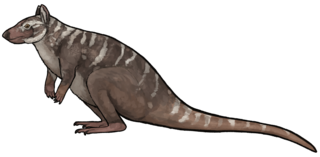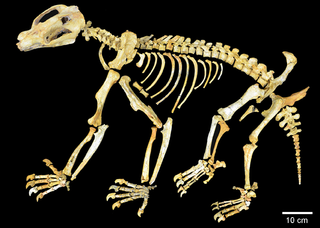
Obdurodon is a genus of extinct platypus-like Australian monotreme which lived from the Late Oligocene to the Late Miocene. Three species have been described in the genus, the type species Obdurodon insignis, plus Obdurodon dicksoni and Obdurodon tharalkooschild. The species appeared much like their modern day relative the platypus, except adults retained their molar teeth, and unlike the platypus, which forages on the lakebed, they may have foraged in the water column or surface.

The order Peramelemorphia includes the bandicoots and bilbies. All members of the order are endemic to Australia-New Guinea and most have the characteristic bandicoot shape: a plump, arch-backed body with a long, delicately tapering snout, very large upright ears, relatively long, thin legs, and a thin tail. Their size varies from about 140 grams up to 4 kilograms, but most species are about one kilogram.

Wakaleo is an extinct genus of medium-sized thylacoleonids that lived in Australia in the Late Oligocene and Miocene Epochs. Although much smaller than its close relative, the marsupial lion, Wakaleo would have been a successful hunter. It had teeth specially designed for cutting and stabbing. The genus is from an extinct family of Vombatiformes, so it is distantly related to the herbivorous wombats.

Ekaltadeta is an extinct genus of marsupials related to the modern musky rat-kangaroos. Ekaltadeta was present in what is today the Riversleigh formations in Northern Queensland from the Late Oligocene to the Miocene, and the genus includes three species. The genus is hypothesized to have been either exclusively carnivorous, or omnivorous with a fondness for meat, based on the chewing teeth found in fossils. This conclusion is based mainly on the size and shape of a large buzz-saw-shaped cheek-tooth, the adult third premolar, which is common to all Ekaltadeta.

Nimbadon is an extinct genus of marsupial, that lived from the Late Oligocene to the Miocene epoches. Many fossils have been found in the Riversleigh World Heritage property in north-western Queensland. It is thought to have an arboreal lifestyle.

Litokoala is an extinct genus of marsupials, and along with Nimiokoala, is closely related to the modern koala. The three genera may have diverged at an earlier date, although the drying of the continent and the expansion of Eucalyptus forests towards the late Miocene may have delayed the evolution of cranial features unique to the modern genera. This indicates that either fossil genus could be an ancestor of the modern genus, or the modern genus has a common ancestor to both. More material needs collection to improve their taxonomical relationships.
Naraboryctes philcreaseri is a fossil species of marsupial found at early Miocene deposits of Boodjamulla National Park of Riversleigh area, northwestern Queensland, Australia.
The Macropodidae are an extant family of marsupial with the distinction of the ability to move bipedally on the hind legs, sometimes by jumping, as well as quadrupedally. They are herbivores, but some fossil genera like Ekaltadeta are hypothesised to have been carnivores. The taxonomic affiliations within the family and with other groups of marsupials is still in flux.
Eoanseranas handae, also sometimes referred to as Hand's dawn magpie goose, is an extinct genus and species of bird. Allied to the family Anseranatidae, which are represented by modern magpie geese, it existed during the Late Oligocene or Early Miocene of northern Australia. It was described from fossil material found at a Carl Creek Limestone site at Riversleigh, in the Boodjamulla National Park of northwestern Queensland. It was slightly smaller than its perceived descendant, the extant magpie goose Anseranas semipalmata.
Cookeroo is a genus of extinct kangaroos from the Late Oligocene and Early Miocene found in fossil deposits from the Riversleigh World Heritage Area, in Australia. The genus includes two species, C. bulwidarri and C. hortusensis.

Microleo attenboroughi is a very small species of the Thylacoleonidae family of marsupials from the Early Miocene of Australia, living in the wet forest that dominated Riversleigh about 18 million years ago. The genus Microleo is currently known from a broken palate and two pieces of jaw, containing some teeth and roots that correspond to those found in other species of thylacoleonids. The shape and structure of the blade-like P3 tooth, a premolar, distinguished the species as a new genus. It was found in Early Miocene-aged deposits of the Riversleigh fossil site in Queensland, regarded as one of the most significant palaeontological sites yet discovered, and named for the naturalist David Attenborough in appreciation of his support for its heritage listing. The anatomy of Microleo suggests the genus is basal to all the known thylacoleonids, known as the marsupial lions, although its relative size prompted one discoverer to describe it as the "feisty" kitten of the family.
Riversleigh fauna is the collective term for any species of animal identified in fossil sites located in the Riversleigh World Heritage Area.
Joculusium muizoni is a fossil species discovered at the Riversleigh World Heritage Area. Little is known about the animal.
Brevipalatus mcculloughi is a species of bat that existed in the early Miocene. It was discovered at a fossil deposit of the Riversleigh World Heritage Area.
Hipposideros winsburyorum is a hipposiderid species of bat known by fossil specimens, one of the many new taxa of chiropterans discovered in the Riversleigh World Heritage Area. The species existed during the Pliocene.

Crash bandicoot is an extinct bandicoot, known from fossils located at the Riversleigh World Heritage Area in northeast Australia.
Liyamayi dayi is a mammal species of the Thylacomyidae family known from fossils located at the Riversleigh World Heritage Area in northeast Australia. The discovery of the specimens was identified as deposited around fifteen million years ago, revising the earliest record of this peramelemorphian lineage from those of species that existed around ten million years later.
Karen H. Black, born about 1970, is a palaeontologist at the University of New South Wales. Black is the leading author on research describing new families, genera and species of fossil mammals. She is interested in understanding faunal change and community structure in order to gain new understandings of past, current and future changes in biodiversity which are driven by climate.
Lekaneleo roskellyae is a fossil species of carnivorous marsupial that existed during the early Miocene in Australia. Once allied to the type species of the genus Priscileo, later placed as Wakaleo pitikantensis, "Priscileo" roskellyae was subsequently transferred to its own genus Lekaneleo.
Bettongia moyesi is a fossil species of potoroid marsupial.










